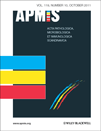VIM and IMP metallo-β-lactamases and other extended-spectrum β-lactamases in Escherichia coli and Klebsiella pneumoniae from environmental samples in a Tunisian hospital
Abstract
Chouchani C, Marrakchi R, Ferchichi L, El Salabi A, Walsh TR. VIM and IMP metallo-β-lactamases and other extended-spectrum β-lactamases in Escherichia coli and Klebsiella pneumoniae from environmental samples in a Tunisian hospital. APMIS 2011; 119: 725–32.
An extremely drug-resistant Enterobacteriaceae species emerged in Kasserine Hospital, Tunisia between 2009 and 2010 causing a local outbreak. We aimed to characterize extended-spectrum β-lactamase (ESBL) and metallo-β-lactamase (MBL)-producing Enterobacteriaceae from the hospital environment. Swabs were collected from ten different wards from Kasserine Hospital, Tunisia. A total of 46 isolates were cultured onto MacConkey agar supplemented with ceftazidime to select for ESBL-producing Enterobacteriaceae. Identification and susceptibility patterns were performed using Phoenix-automated phenotypic identification criteria. Extended spectrum β-lactamases (ESBLs) were detected using cefepime ESBL E-test. Colony blotting was first used to detect the occurrence of blaSHV, blaCTX-M, blaCMY, blaIMP, and blaVIM genes. PCR was used to amplify these genes, and the amplicons were sequenced and analyzed. Total DNA was digested with XbaI, and PFGE was used to type the major isolates that produced IMP-1. Among the 46 isolates, 63% were Klebsiella pneumoniae, 13% were Escherichia coli, 8.7% were Proteus mirabilis, 6% were Enterobacter cloaceae, 4.3% were Providencia rettgeri, 2.5% were Serratia marcescens, and 2.5% were Pantoea agglomerans. PCR amplification and DNA sequencing showed that hospital environment isolates produced SHV-125, CTX-M-15, CMY-2 ESBLs, and IMP-1 and VIM-2 MBLs. PFGE typing showed the emergence of IMP-1 MBL-producing K. pneumoniae isolates that were not clonal. In this study, we report the first characterization of IMP-1 and VIM-2 MBL-producing K. pneumoniae and E. coli isolates collected from Kasserine Hospital, Tunisia.




